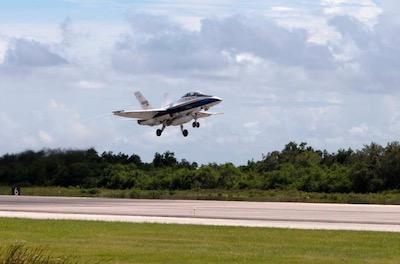Testing Program Got Underway November 5
NASA has begun a series of quiet supersonic research flights off the coast of Texas near Galveston to test ways to measure the community’s response to a unique acoustic experience. Normally, an aircraft flying at supersonic speeds (faster than Mach 1, the speed of sound) produces a sonic boom so loud that, today, commercial supersonic flight is prohibited over land.

On November 5, NASA test pilots began flying an F/A-18 supersonic research aircraft in a unique maneuver that creates a quieter “thump.” Capturing how people and sensors on the ground respond to that sound is the goal for the Quiet Supersonic Flights 2018, or QSF18, campaign. “QSF18 is a big step in NASA’s efforts to understand what is required for acceptable supersonic overland flight,” said NASA’s Commercial Supersonic Technology Project Manager Peter Coen. “This is the first time in decades that we have reached out to a large community as part of our supersonic research. NASA has performed similar tests at our Armstrong Flight Research Center, using similar sounds created by the same F/A-18. We’ve measured the noise levels and the impact on structures, as well as surveyed people for annoyance, to make certain that these tests are safe and well-planned. We greatly appreciate Galveston’s interest and support.”
The F/A-18 is a typical supersonic aircraft so, in order to shush the boom, it will be put into a quiet supersonic dive maneuver. Starting out over the water at around 50,000 feet the aircraft will be put into a special dive that still creates a regular sonic boom, however when the sound reaches land it should be heard as a quieter “thump” instead.
QSF18 is unique for another reason. For the first time, NASA’s Johnson Space Center, located just north of Galveston, will provide critical support for a NASA activity is about flight but not into space! The center’s flight operations staff are part of the team supporting the QSF18 aircraft, pilots and other crew based out of nearby Ellington Field. “NASA’s role as a leader into new frontiers paves the way forward towards new technologies, opportunities, and milestones across multiple endeavors, as we have always done throughout our history,” said Mark Geyer, director of NASA’s Johnson Space Center. “As our efforts also continue to expand our boundaries and capabilities in space, Johnson Space Center is proud to be working with our colleagues at NASA’s research centers at Langley and Armstrong, and to take part in the agency’s aeronautics research efforts to lead aviation into a new era as ‘One NASA.’”

In Galveston, community feedback data will be gathered through the use of a survey, in which 500 recruited volunteer residents, if they hear the thumps, will define the level at which they were able to perceive the sound. QSF18 data will be used to help NASA better understand successful data collection methods for future flights using an experimental aircraft called the X-59 Quiet Supersonic Technology, or QueSST, demonstrator. Starting in 2022, the X-59 will directly fly over yet-to-be-selected communities to collect data using lessons learned from QSF18.
“Galveston is both honored and excited to be part of this project,” said Galveston Mayor James Yarbrough. “This is the type of project that motivates engineers and innovators. In Galveston, we have a long and proud history of being involved in advances in science and technology, whether that’s in medicine, rail, or shipping. In this case, our residents will have an opportunity to participate in a study to advance aviation and the design of commercial planes that can break the sound barrier quietly. We’re excited to be a small part of it, and we’ll do what we can to support NASA and help ensure the success of this study. Thanks to NASA for choosing Galveston as the location for testing this idea.”
While the “quiet thumps” produced by the F/A-18 present no risk of causing physical damage to people or structures, NASA has learned that elements such as atmospheric turbulence and humidity can influence how certain areas may perceive the sound, which may be heard differently from other areas. NASA will operate a number of microphone stations in the area to match up the community’s response with the decibel level of each sonic thump.
Additionally, NASA will have resources available to residents who would like to learn more about supersonic flight research, and how it may help lead to an exceptional reduction in commercial flight times. NASA has committed to engage the educators and youth of the Galveston area, through STEM learning activities. This features two web-based opportunities, including a “Seeing Sound” learning module, with classroom activities for students, and a citizen scientist activity for anyone in the Galveston area to submit data on the sounds they hear. (This activity is separate from the process of collecting official data responses from pre-selected community volunteers.)
(Images provided with NASA news release)
 Aero-News: Quote of the Day (11.02.25)
Aero-News: Quote of the Day (11.02.25) ANN's Daily Aero-Term (11.02.25): Inner-Approach OFZ
ANN's Daily Aero-Term (11.02.25): Inner-Approach OFZ Classic Aero-TV: MultiGP Drone Racing - Aviations New Action Sport
Classic Aero-TV: MultiGP Drone Racing - Aviations New Action Sport ANN's Daily Aero-Term (11.03.25): On-Course Indication
ANN's Daily Aero-Term (11.03.25): On-Course Indication Airborne 10.29.25: X-59 Flies!!!, Kings Aid CFIs, Shutdown Hurts ATC Training
Airborne 10.29.25: X-59 Flies!!!, Kings Aid CFIs, Shutdown Hurts ATC Training




